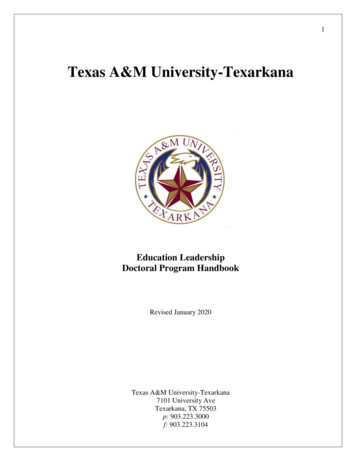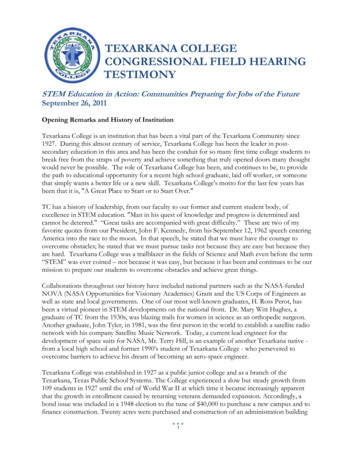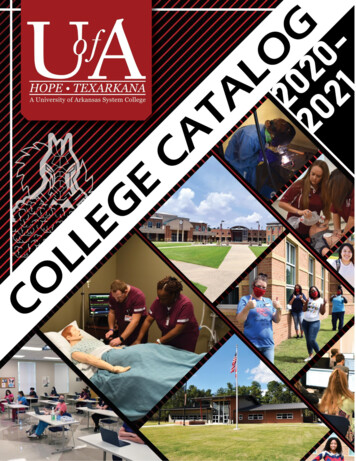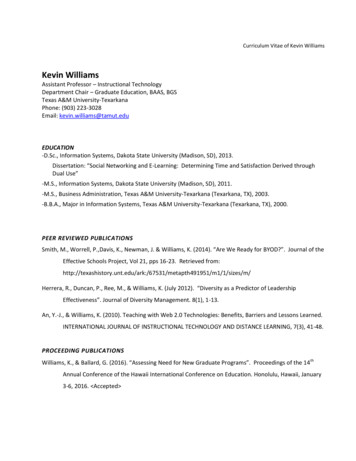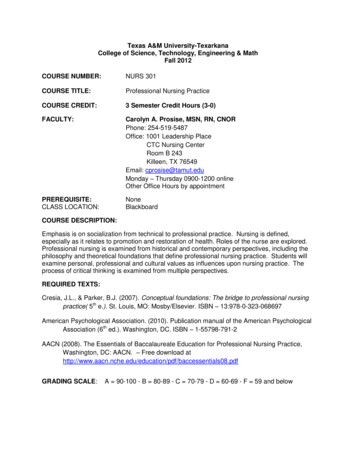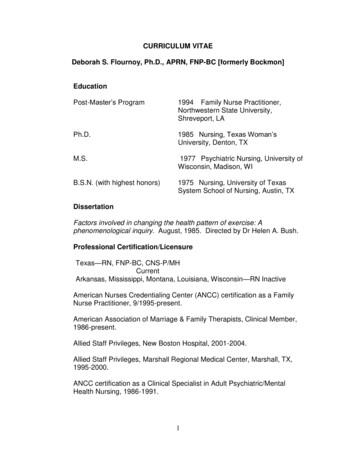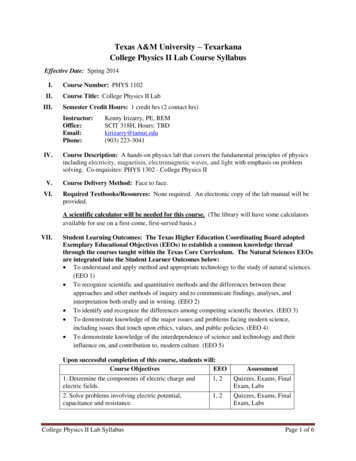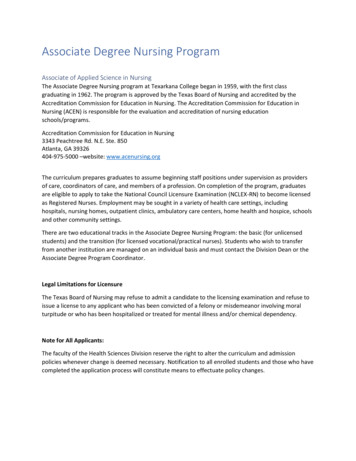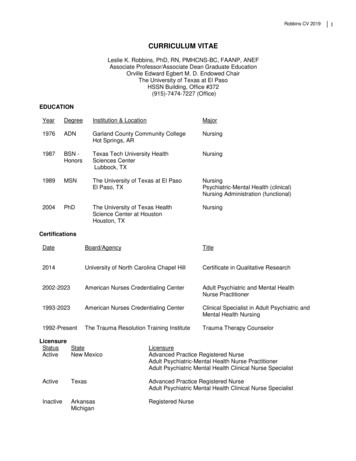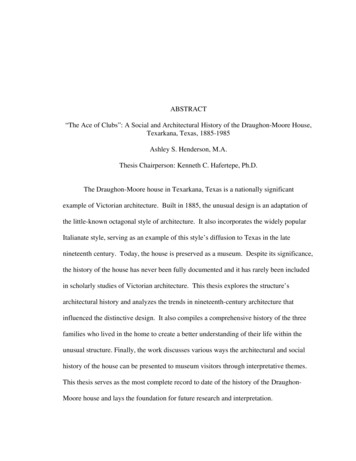
Transcription
ABSTRACT“The Ace of Clubs”: A Social and Architectural History of the Draughon-Moore House,Texarkana, Texas, 1885-1985Ashley S. Henderson, M.A.Thesis Chairperson: Kenneth C. Hafertepe, Ph.D.The Draughon-Moore house in Texarkana, Texas is a nationally significantexample of Victorian architecture. Built in 1885, the unusual design is an adaptation ofthe little-known octagonal style of architecture. It also incorporates the widely popularItalianate style, serving as an example of this style’s diffusion to Texas in the latenineteenth century. Today, the house is preserved as a museum. Despite its significance,the history of the house has never been fully documented and it has rarely been includedin scholarly studies of Victorian architecture. This thesis explores the structure’sarchitectural history and analyzes the trends in nineteenth-century architecture thatinfluenced the distinctive design. It also compiles a comprehensive history of the threefamilies who lived in the home to create a better understanding of their life within theunusual structure. Finally, the work discusses various ways the architectural and socialhistory of the house can be presented to museum visitors through interpretative themes.This thesis serves as the most complete record to date of the history of the DraughonMoore house and lays the foundation for future research and interpretation.
"The Ace of Clubs": A Social and Architectural History of the Draughon-Moore House,Texarkana, Texas, 1885-1985byAshley S. Henderson, B.A.A ThesisApproved by the Department of Museum StudiesKenneth C. Hafertepe, Ph.D., Interim ChairpersonSubmitted to the Graduate Faculty ofBaylor University in Partial Fulfillment of theRequirements for the DegreeofMaster of ArtsApproved by the Thesis CommitteeKenneth C. Hafertepe, Ph.D., ChairpersonEllie B. Caston, Ph.D.Thomas L. Charlton, Ph.D.Accepted by the Graduate SchoolAugust 2008J. Larry Lyon, Ph.D., DeanPage bearing signatures is kept on file in the Graduate School.
Copyright 2008 Ashley S. HendersonAll rights reserved
TABLE OF CONTENTSLIST OF FIGURESvACKNOWLEDGMENTSviiiDEDICATIONixCHAPTER ONE: Introduction1CHAPTER TWO: Families of the Draughon-Moore House3The Draughon FamilyThe Whitaker FamilyThe Moore FamilyCHAPTER THREE: Architecture of the Draughon-Moore House43Building the Draughon-Moore HouseArchitecture of the Draughon-Moore HouseQuestions about the Original HouseThe Legend of the Ace of ClubsOctagonal ArchitectureOctagonal InfluenceThe Italianate StyleMr. Draughon’s OctagonCHAPTER FOUR: A Century of Change76The 1901 RenovationLater Alterationsiii
Unanswered QuestionsRestoring the Draughon-Moore HouseCHAPTER FIVE: Interpretation of the Draughon-Moore House99Life Within the RoomsConsumerism of the FamiliesServants in the HouseUse of the ThemesCHAPTER SIX: Conclusion124APPENDIX126BIBLIOGRAPHY137iv
LIST OF FIGURES1.James Harris Draughon102. Susan Medora Dunn WhitakerWilliam Loundes Whitaker173.Henry Moore Sr.Katharine Fleming Moore304.Colonel Charles Beatty Moore with King Ferdinand of Romania,near Warsaw, Poland, June 26, 1873335.Henry Moore Jr., 1922Olivia Smith Moore, c. 1920366.Katharine Elizabeth Moore Unsworth, c. 1942407. Henry Moore III, c. 1950418.Draughon-Moore house, perspective map c. 1888459.Basement level floor plan of the Draughon-Moore house4710.Draughon-Moore house, 1888 Sanborn fire insurance map5011.George E. Woodward’s plan for “An Octagonal Cottage”George E. Woodward’s plan for “A Country House”6812.Arkansaw Cotton Seed Oil Mill offices, 1888 Sanborn fire insurance mapArkansaw Cotton Seed Oil Mill offices, perspective map c. 18887013.Draughon-Moore house, 1900 Sanborn fire insurance map7814.West porch and entryway, c. 19057815.Draughon-Moore house, 1905 Sanborn fire insurance map80v
16.Draughon-Moore house, 1915 Sanborn fire insurance map8717.Formal parlor, located in north octagonal room, after 1985 renovation9418.Dining room, located in the east rectangular room, after 1985 renovationDraughon room, located in the south octagonal room, after 1985 renovation9619.Draughon-Moore house, 20029820.Whitaker family dining room, c. 189011321.John and Bertha, c. 1930Unknown male servant, c. 1950s12023.Katharine’s “Rogue Gallery,” Scrapbook page created by ElizabethBonner Smith, early 1920s123A.1.Alice Draughon, c. 1895127A.2.William Loundes Whitaker, 1873128A.3.Norman Whitaker, c. 1905128A.4.Katharine Fleming Moore and Henry Moore Sr., c. 1901-1905129A.5. Mildred Moore Carter, 1898130A.6.Henry Moore Jr., c. 1901 to 1904130A.7.Charles Beatty Moore in United States Army uniform131A.8.Military maneuvers near Warsaw, Poland, June 26, 1923131A.9.Olivia Smith Moore and Texas High girls basketball team, 1911132A.10.Olivia Smith Moore behind the wheel of an early automobile, c. 1910s132A.11.Katharine Moore Unsworth playing in front of the Draughon-Moorehouse, 1924133A.12.Katharine Moore Unsworth posing in a dance costume on the northwestSide of the Draughon-Moore house, c. 1928133A.13. Four generations, 1944134vi
A.14.Henry Moore III and Olivia Smith Moore celebrating Henry’s birthdayat the family’s lake house, 1940s134A.15.Draughon-Moore house, c. 1903135A.16. Draughon-Moore house south side, c. 1905135A.17.136Unidentified male servant with horses Cake Walk and Lady Bird, c. 1905A.18. Draughon-Moore house, c. 1940s136vii
ACKNOWLEDGMENTSI would like to thank Melissa Nesbitt, Curator of the Draughon-Moore Collection,for answering my endless questions and sharing my excitement over new discoveries, andthanks to the staff of the Texarkana Museums System for supporting my research. Iwould also like to express my gratitude to my thesis chairperson Dr. Kenneth Hafertepefor sharing his extensive knowledge of historic architecture and assisting me inunraveling the complicated history of this historic house, and to my committee membersDr. Ellie Caston and Dr. Thomas Charlton for their support. Thanks also to AshleyRasner for keeping me sane this year. Most importantly, I would like to thank myparents, Larry and Cathy Henderson, my sister Katelyn, and the rest of my incrediblefamily for their love and support through years of school when everyone else asked,“And what will you do with that degree?”viii
To my Granddaddy, Hal Redwine Henderson, 1921-2007
CHAPTER ONEIntroductionWhile others in the small town of Texarkana, Texas-Arkansas were celebratingJuly 4, 1885, with picnics and bonfires, the Draughon family was moving into a newhome. Their house had been constructed in less than six months and the exteriorscaffolding was still in place, waiting for the workers to complete the finishing touches.In the excitement of this day, it surely never entered the minds of the Draughon familymembers that, over a century later, others would preserve, visit, and study their familyhome. Their house is known today as the Draughon-Moore house and is preserved as theonly historic house museum in the Texarkana area.Few Victorian homes survive in Texarkana. Mr. Draughon’s house was sparedfrom neglect or destruction because of the general fascination with the very unusualarchitectural design he chose for his home. The structure consists of a basement and twoupper floors, all with the same floor plan of four clustered octagonal rooms connected toa rectangular wing. From above, the house resembles the ace of clubs, and is in factbetter known to many people as The Ace of Clubs House. This curious floor plan is aunique adaptation of the octagonal style of architecture, which achieved limitedpopularity during the mid-nineteenth century. Remarkably, this stunning home has onlybeen included in a few scholarly publications. Major works surveying Texas architecturehave never included the house, perhaps because it stands just a few hundred yards fromthe state line of Texas and Arkansas. This study explores the Victorian architecturalstyles that influenced the home’s design and is the first to thoroughly document the1
architecture and alterations to the house over time, thereby creating an important recordof the structure’s history.Although the primary significance of the Draughon-Moore house is architectural,the home also serves as an important venue for discussing life in early Texarkana.Members of the Draughon, Whitaker, and Moore families who lived in the home playedimportant roles in Texarkana’s industrial and civic development. This work establishes anarrative history of the families, bringing to light many new facts about their personaland public lives. This history also enhances the understanding of family life within theDraughon-Moore house.Finally, this work suggests interpretive themes for future public programs in thehouse. These themes organize the many facts and objects presented in the DraughonMoore house into key ideas in order to enhance the visitor’s comprehension of thehome’s history. The themes address the family’s lives within the rooms, the developingconsumer culture that is displayed within the structure, and the significant presence ofdomestic servants within the home over the course of its history.2
CHAPTER TWOFamilies of the Draughon-Moore HouseThree families lived in the Draughon-Moore house over its century as a home.These families played an important part in the history of Texarkana, helping to establishthe town, promote industry, improve commerce, and preserve history. Mr. James HarrisDraughon represented the adventurous spirit of an expanding nation at the end of thenineteenth century. He moved frequently in search of new business ventures. Althoughhe was only a resident for a short period, Draughon helped the small town of Texarkanagrow into a booming city. Most of his accomplishments are forgotten today, but thehome he built in 1885 stands as a mark of his influence and unique personality. W. L.Whitaker was the son of one of the area’s first settlers. He was a tireless entrepreneurwho helped to make Texarkana a great railroad center. Henry Moore Sr. was the last topurchase the Draughon-Moore house. Three generations of his family lived in the homeand quietly worked to improve Texarkana. Mrs. Olivia Smith Moore donated her hometo the people of Texarkana for its preservation as a symbol of the area’s early history in1985.The Draughon FamilyJames Harris Draughon was born on June 12, 1843, in Waverly, Tennessee.1 Hewas the youngest child of William W. and Cassandra Murphy Draughon. William, a1Portrait and Biographical Record of Oklahoma: Commemorating the achievements of citizenswho have contributed to the progress of Oklahoma and the development of its resources (Chicago:Chapman Publishing, 1901), 728. Historical records often spell his surname Draughn.3
native of North Carolina, spent his early years as a farmer before entering the hotelbusiness as owner of the Waverly Inn. In the same year that James was born, his fatherdied suddenly while on a trip to Canton, Mississippi leaving his widow with seven smallchildren.2 James’s mother Cassandra was born in Virginia, the daughter of an Irishimmigrant planter. Cassandra raised her children with the help of her mother, MargaretMurphy.3 Little is known about James’s early life other than he spent his childhood inWaverly, Tennessee and attended public schools. He became a store clerk at justfourteen years of age in Dresden, Tennessee and developed his transient habits early,relocating to Hickman, Kentucky and then Carroll, Tennessee in the course of only twoyears.At the start of the Civil War, J. H. Draughon joined the Confederate Army. Hespent two months as part of the Memphis Independent Dragoons before enlisting in the22nd Tennessee Infantry, also known as Freeman’s Regiment, in August 1861.4 The unitparticipated in the Battle of Shiloh in April 1862 before merging in June with the 12thTennessee Infantry Regiment.5 A 1901 biography stated that Draughon achieved therank of first lieutenant, was wounded in the hand at the Battle of Shiloh, and wascaptured at Dresden, Tennessee.62Portrait and Biographical, 728.3U.S. Bureau of the Census, Seventh Census of the United States, 1850 (Washington, D.C.:National Archives and Records Administration, 1850), http://search.ancestry.com/cgi-bin/sse.dll?db 1850usfedcenancestry&indiv try&h 6268219 (accessed March 8, 2008).4Portrait and Biographical, 728. U.S. National Park Service, “J. H. Draughn”, Civil War Soldiers& Sailors System, http://www.civilwar.nps.gov/cwss/index.html (accessed January 8, 2008).5U.S. National Park Service, “22nd Regiment, Tennessee Infantry”, Civil War Soldiers & SailorsSystem, http://www.civilwar.nps.gov/cwss/index.html (accessed January 8, 2008).6Portrait and Biographical, 728.4
After the war, Draughon’s adventures led him to the western frontier. In thespring of 1864, he traveled to San Francisco, California. Instead of traveling across thecontinent, he sailed to Panama, took the Panama Railroad across the isthmus, and thensailed on to California. After a short visit in San Francisco, Draughon moved to VirginiaCity, Nevada where he worked as a bookkeeper for a grocery and toll road firm.7 Eitherhe planned this as a temporary adventure or he quickly became bored because after onlyeight months he returned home by the same route. J. H. Draughon then moved toCincinnati and enrolled in Bacon Commercial College. After completing businesscourses, he moved to Paducah, Kentucky and worked as a clerk for a year before openinghis own general merchandise store in his hometown of Waverly, Tennessee.In 1866, Draughon married Alice Spencer, a native of Indiana who was born onDecember 25, 1847.8 With a new business and family, James might have thought aboutsettling down. However, after just two years he moved his family to Gardner Station,Tennessee in 1868. Similar to their future home of Texarkana, Gardner Station was aninfant town that was not incorporated until 1869. In this location, J. H. Draughon firstshowed his entrepreneurial talent for relocating to new towns to start successfulmercantile stores. By 1870, Mr. Draughon was comfortably situated with a combinedreal and personal property value of 7,500.9 His wife Alice, then 24 years of age, kept7Portrait and Biographical, 728.8U.S. Bureau of the Census, Ninth Census of the United States, 1870 (Washington, D.C.: NationalArchives and Records Administration, 1870), http://search.ancestry.com/cgi-bin/sse.dll?indiv 1&rank 1&gsfn J H&gsln Draughn& &f5 TN&f4 &f7 &f21 &rg 81004011 date &rs 81004011 date 0&f15 n &f28 &gskw &prox 1&db 1870usfedcen&ti 0&ti.si 0&gss angs-d&pcat 35&fh 0&recid 36248692&recoff 1 2 3 47 (accessed March 8, 2008). “Rose Hill Cemetery,” Texarkana USAGenealogical Society, http://www.rootsweb.ancestry.com/ txkusa/Cemeteries/rosehillce.htm (accessedJune 10, 2008).9U.S. Bureau of the Census, Ninth Census, www.ancestry.com.5
house. Along with the children, Addie and James W. Draughon, James’s motherCassandra also lived with the family.In 1870, Draughon moved his family again, settling in Forest City, Arkansas. Itwas likely here that the Draughon’s third child, Alice, was born. In this small town, heestablished another general store and also built a sawmill. George W. Bottoms, a youngman Draughon hired to assist in his Gardner Station store, moved with the family andbegan working at the sawmill.10 In Forest City, Draughon and Bottoms becameassociated with another lumberman William Buchanan. In 1873, the three men saw apromising opportunity to build their fortunes and relocated to the new town of Texarkana.Although settlers arrived in the area as early as 1814, the city of Texarkana, Texaswas not officially organized until December 1873, when the first train of the Texas andPacific Railroad rolled into town.11 Draughon, Buchanan, and Bottoms quicklyestablished a sawmill near the center of town under the name Buchanan and Company.Building in the town boomed and the business prospered by creating lumber from thetrees cleared from the city lots and streets.12 Although this company dissolved after a fewyears, each of the men continued their involvement in the lumber industry, which thrivedin the Piney Woods area. Mr. George W. Bottoms remained in the Texarkana area andwas involved in several sawmills. He made a small fortune and built another one ofTexarkana’s beautiful early homes. William Buchanan built what was considered one of10Barbara Overton Chandler and J. Ed Howe, History of Texarkana and Bowie and MillerCounties, Texas-Arkansas (Shreveport, LA: J. Ed Howe, 1939), 302.11Les Minor et al, Images of Texarkana: A Visual History; Life and Times of Arkansas and TexasBorder Cities (Marceline, MO: Heritage House Publishing, 1991), 5.12Chandler and Howe, History of Texarkana, 302. Biographical and Historical Memoirs ofSouthern Arkansas: A Condensed History of the State .(1890; repr., Easley, SC: Southern Historical Press,1978), 186.6
the largest lumber businesses in the Southwest and began the Louisiana and ArkansasRailway Company. The three men crossed paths in several other business ventures andsociety over the years.In Texarkana, J. H. Draughon also continued his career in the mercantile business,starting the dry-goods store of Hakes & Draughon. After two years, he ended thispartnership and started an independent store. In 1882, he was running a general storewith George W. Bottoms under the name J. H. Draughon & Company.13 Over the years,he expanded this business and bought out several other merchants. He frequentlytraveled to major commercial cities, such as St. Louis, to purchase goods bringing thelatest fashions and new technologies to the Texarkana area.Texarkana boomed as a railroad center in the 1870s and 1880s. J. H. Draughonwas skilled in seeing the many entrepreneurial opportunities. He dabbled in a variety ofbusinesses and helped build commerce in the young town. He invested in real estate andowned several business buildings in the center of town including a hotel.14 He alsofrequently constructed buildings in the business district. In 1881, he served as thepresident of the Texarkana Building and Savings Association.15 He later served as vicepresident and president of the First National Bank of Texarkana.16 He held this positionfor ten years and helped make the bank one of the most reliable in the State of Texas, a13Nancy Watts Jennings and Mary Lou Stuart Phillips, Texarkana Centennial Historical Program,1873-1973 (Texarkana: Texarkana Centennial Association, 1973), 8.14Daily Texarkana Independent, May 1, 1885, microfilm.15Daily Texarkana Independent, August 18, 1881, microfilm.16Daily Texarkana Independent, October 30, 1884, microfilm.7
major accomplishment in a period when banks were prone to failure.17 The stockholdersof the Fort Smith and Sabine Pass Railroad also elected him as vice-president in 1885.18Draughon joined other men in building modern utilities in the growing city includinggasworks and waterworks facilities.19 However, neither of these utilities received enoughsupport to reach completion. He also held stock in area sawmills, including one in Genoathat turned a profit of 12,000 when he sold it to George Bottoms.20 In May 1885, hewas part of what was believed to be the largest transaction in Texarkana history up to thattime, exchanging several brick buildings including his Arlington Hotel for Mr. A.Goldberg’s store merchandise at a value of 21,000.21 At his death, an obituary in theDallas Morning News stated, “He was very active in those early days, very popular, andat one time, it was estimated, owned nearly 25 percent of the material wealth of thetown.”22Aside from his business ventures, J. H. Draughon was also interested indeveloping Texarkana’s civic aspects. He served as the second mayor of Texarkana,Texas and also a city alderman for six years.23 When the city of Texarkana, Arkansas17Portrait and Biographical, 729.18Daily Texarkana Independent, May 19, 1885, microfilm.19Daily Texarkana Independent, April 22, 1885, microfilm. Daily Texarkana Independent,November 4, 1885, microfilm.20Chandler and Howe, History of Texarkana, 302.21Daily Texarkana Independent, May 5, 1885, microfilm.22“Texarkana Pioneer Dies in Memphis,” Dallas Morning News, October 11, 1913,www.newsbank.com (accessed June 15, 2008).23Portrait and Biographical, 729.8
incorporated in 1880, he served as the first town treasurer.24 One intriguing story of thetown’s development claims J. H. Draughon served as captain of a citizen’s committee, orgroup of vigilantes that cleared out the town’s lawbreakers in 1881. These lawbreakerswere mostly gamblers and were accused of robbing citizens at night and fleecing men inthe saloons during the day while corrupt city officials looked the other way. A group offorty citizens, with J. H. as captain, took to the streets with guns and rounded up abouttwenty-five corrupt city officials and gamblers. They ran them to the town’s edge andtold them to never enter the city again.25 If this story is true, the effort did not changethings for long and the booming town was known as a hotspot for saloons and crimes intothe nineteenth century due in part to its location on the state line. In 1884, Mr. Draughonserved for a short time as a trustee on the board for public schools on the Texas side. Heresigned from this position because, while he supported the free schools, it was generallynoted that others on the mayor-appointed board were against them and did everything toprevent their proper functioning.26While he was doing so much to build Texarkana, it appears J. H. was still lookingacross the nation for his next business prospect. One newspaper account from October1884, commented that J. H. was speaking of leaving within the year for Colorado.27 Thelocal newspaper noted several times between 1884 and 1885 that they hoped the new24Chandler and Howe, History of Texarkana, 87.25Maude Davis Blankenship, “A History of Texarkana: My Texarkana,” (master’s thesis, EastTexas State Teachers College, 1950), 18. “Texarkana, Texas, Mayors Have Been Fighting for City’sWelfare, Growth, Since June 1874,” Texarkana Gazette, September 26, 1943, Draughon-Moore CollectionArchives, Texarkana Museums System.26Daily Texarkana Independent, September 23, 1884, microfilm.27Daily Texarkana Independent, October 10, 1884, microfilm.9
business ventures of Mr. Draughon meant that he had abandoned plans to leave the city.One article stated that he was possibly moving to Kansas.28 However, Mr. Draughondecided to remain in the town for a while longer and build a modern home for his family.Figure 1. James Harris Draughon. It is estimated that he owned as much as 25 percent of the wealth ofTexarkana at one point. Courtesy Texarkana Museums System.After a decade of success in Texarkana, J. H. Draughon purchased two lots for hisPine Street home in January 1885, and another adjoining lot in May 1885 after buildingcommenced.29 On January 17, 1885, the Daily Texarkana Independent announced J. H.Draughon’s intentions to build a large brick home on the lot. At the time, the Draughonfamily was living above his mercantile store. The store was part of a large brick buildingwith at least three stories that was referred to as the Marx Block. The structure included28Daily Texarkana Independent, January 17, 1885, microfilm.29Beverly J. Rowe to Katy Caver, Acquisition information on lots in block 4, August 29, 1988,Draughon-Moore Collection Archives, Texarkana Museums System.10
several businesses and two other families living in the upper floors. Although thebuilding was considered one of the finest in the Texarkana area, it clearly did not makethe same statement of wealth as Mr. Draughon’s new home. Less than a month afterannouncing his plans to build his Pine Street home, fire destroyed his store and residenceand the Draughon family barely escaped. The entire Marx Block was destroyed at anestimated loss of 210,000, a fortune for the period. 30 The water systems and firedepartments of the town were still in their infancy and large fires were not an unusualoccurrence in Texarkana at the time.This great loss surely encouraged Mr. Draughon in the rapid construction of hisnew home. Newspaper accounts commented occasionally over the spring of 1885 aboutthe speedy work going on. Just before the home was finally completed, tragedy againstruck the Draughon family. Their baby girl, born the previous November, died of amysterious disease on June 25, 1885.31 Daughters Alice and Addie Draughon returnedhome from school in St. Louis for the summer on the 27th.32 On July 4th weekend of1885, with a cloud of grief still hanging over the family, the Draughons moved into theirstunning new home.33While the business interests of Mr. Draughon were recounted in Texarkananewspapers, less was said about the family’s social life. Like many upper-class childrenin nineteenth-century Texarkana, the Draughon daughters attended boarding school fortheir education. Both Addie and Alice graduated from the school at Maryville Convent30Daily Texarkana Independent, February 21, 1885, microfilm.31Daily Texarkana Independent, June 25, 1885, microfilm.32Daily Texarkana Independent, June 27, 1885, microfilm.33Daily Texarkana Independent, July 4, 1885, microfilm.11
in St. Louis, Missouri.34 They returned to Texarkana on holidays, where they attendedparties and entertained female friends in their new home. Addie Draughon married W. J.Gallagher, a Bowie County resident, in 1889.35 James W. Draughon may have alsoattended boarding school and later he joined his father in several businesses. AliceSpencer Draughon appears to have been less active in Texarkana society. According tolater family stories, Alice suffered from what was genteelly termed female troubles,which were treated with laudanum. If true, this condition possibly left her homebound.J. H. Draughon was a member of several social clubs. He was a Royal Arch Mason andwas associated with Texarkana’s Masonic lodge as well as the Knights Templar.36 InJanuary of 1885, Mr. Draughon joined a newly formed literary club with severalprominent men in the community.37The Draughons sold their home in July 1887, only two years after moving in. In1888, Mr. Draughon dissolved most of his business interests in Texarkana and devotedhimself full-time to the Sulphur Lumber Company at Sulphur Station, Arkansas. He firstpurchased stock in this company in November 1885 for 50,000, an extraordinaryinvestment.38 After Alice Spencer Draughon’s early death in 1892, J. H. married Anna34Portrait and Biographical, 729.35Ancestry.com, “Texas Marriage Collection, 1814 -1909 and 1966-2002,” The GenerationsNetwork, http://search.ancestry.com/cgi-bin/sse.dll?indiv 1&rank 1&f3 Addie&f2 Draughon& &rg f5 date &rs f5 date 0&f7 &f10 &f9 &rg f12 date &rs f12 date 0&f14 &f16 &f17 &rgf18 date &rs f18 date 0&f23 Bowie&f21 &gskw &db txmarriageindex&ti 0&ti.si 0&gss angsd&pcat 34&fh 0&recid 3012321&recoff 1 2 18 (accessed March 8, 2008).36Portrait and Biographical, 729.37Daily Texarkana Independent, January 26, 1885, microfilm.38Daily Texarkana Independent, November 12, 1885, microfilm.12
Northern of Lanier, Texas in March 1893.39 Anna was 25 years his junior and around theage of his only son, James. The couple met through James W. Draughon’s wife LucyCocke.40 Although James was reaching his fifties at the point of their marriage, thecouple had at least six children with five surviving. In 1893, the Draughons moved toArkansas where J. H. purchased another sawmill. The small town of Draughon,Arkansas grew around this business. In 1896, the Draughon family moved to St. Louis,Missouri and J. H. began the Draughon Commission Company. He sold this businessand relocated to Shawnee, Oklahoma to establish the Round Bale Cotton Company withhis son in 1898. In this venture, he established plants in five Oklahoma cities and becamean important figure in the state’s economy. In 1901, he served as the vice-president ofthe Cotton Ginners’ Association of Texas, Indian Territory, and Oklahoma.41 Around1903, J. H. Draughon moved his family back to his native state. He spent the remainderof his life in Memphis, Tennessee conducting a real estate business with his son.42 JamesHarris Draughon died on October 8, 1913 at the age of 70.4339“Married,” Texarkana Daily Democrat, March 2, 1893, microfilm.40Ellen Draughon Sereque, Notes on Draughon family, April 30, 1989, Draughon-MooreCollection Archives, Texarkana Museums System.41Portrait and Biographical, 729.42Memphis City Directory (R.L. Polk and Company, 1909), www.ancestry.com (accessed March8, 2008).43Shelby County Register of Deeds, “Board of Health, City of Memphis Burial Permit 13855,”under “Death Records, 1848-1957,” www.register.shelby.tn.us (accessed January 15, 2008).13
The Whitaker FamilyWilliam Loundes Whitaker was born on September 15, 1850 in Bowie County,Texas, just outside of the small village of Texarkana.44 W. L., as he was commonlyknown, grew up in a large family with three sisters and four brothers. The Whitakerfamily was one of the thousands who came to Texas during its Republic days to start anew life. Willis Whitaker, W. L.’s father, traveled from South Carolina with his firstwife Sarah Moores. They were part of a caravan of families led by Sarah’s parents,Charles and Mary Harrison Moores, which arrived in May 1840. Sarah’s eldest brotherwas Eli H. Moores, one of the most well known settlers of Texarkana. Willis settled inwhat was Cass County and began a prosperous farm on a 640-acre land grant he receivedin November 1841.45 Sarah and Willis had six children before her death in 1843. AfterSarah Moores’s death, Willis married her widowed sister Elizabeth Harrison MooresRosborough in 1844.46 This marriage produced five children including William LowndesWhitaker, the 10th child of Willis Whitaker.Born a decade after his father’s arrival in Texas, W. L. Whitaker was spared thefamily’s early hardships. Willis Whitaker’s land holdings grew into a plantation of 1,
16. Draughon-Moore house, 1915 Sanborn fire insurance map 87 17. Formal parlor, located in north octagonal room, after 1985 renovation 94 18. Dining room, located in the east rectangular room, after 1985 renovation 96 Draughon room, located in the south octagonal room, after 1985 renovation 19. Draughon-Moore house, 2002 98 20.

